This content was originally published by the Longmont Observer and is licensed under a Creative Commons license.
Written by Al Pace
The history of Longmont illustrates the importance of newspapers to the public interest by the fact that, in its earliest decade, it had as many as four when its population numbered less than a thousand. Its very first newspaper began in Burlington, that town south of the Saint Vrain that ultimately became part of Longmont. The colonists from Chicago founded Longmont in 1871, and by April, Elmer and Fred Beckwith had founded the Burlington Free Press.
The Burlington Press only printed two issues before the paper moved to Longmont and became the Longmont Sentinel. It later changed its name to the Colorado Press and then to the Longmont Press.
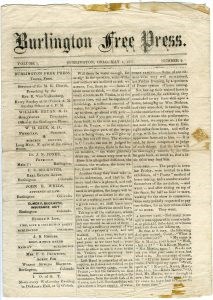
Before long, the Beckwith brothers were competing with The Longmont Inter-Ocean, a local subsidiary of the Chicago Inter-Ocean, and the Valley Home and Farm. The Valley Home and Farm presented the most elaborate masthead, a drawing of a mountain scene with a ribbon below it reading “Devoted to Agriculture, Home Culture, Household Economy, and Topics of the Times.” All were small, weekly papers, but during this era of movable type, every letter had to be set by hand.
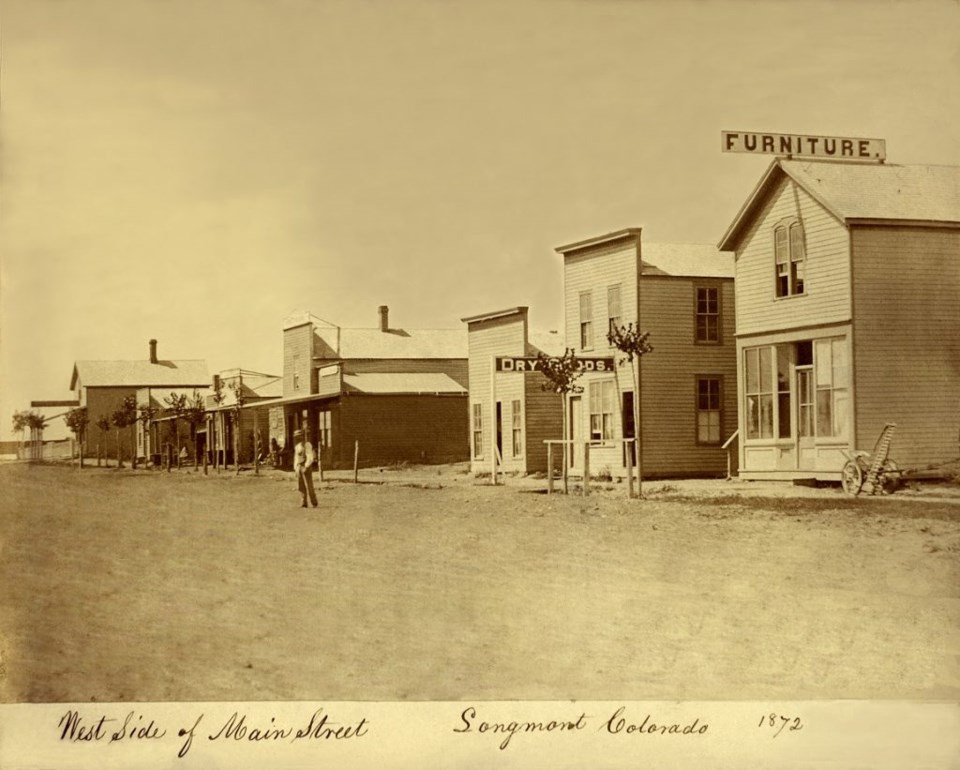
By 1879, yet another newspaper, the Longmont Ledger, was poised to compete with those already serving the town when C. W. Boynton and J. J. Jilson had purchased the equipment of the Valley Home and Farm. On September 12, a fire swept across the east side of Main Street between Third and Fourth avenues destroying the Beckwiths’ premises, so the Longmont Ledger stepped up its scheduled opening and printed its first edition the next day. Although the Ledger printed the Longmont Press for several weeks, the Press closed after struggling for a time.
Boynton worked as a printer and business manager of the Ledger until 1898 when the editor, Henry Hayward, died. Boynton remained as manager and also took over as editor until his own death in June, 1926.
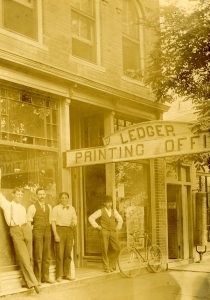
This photo from the Longmont Museum Photo Collection shows Boynton standing with hands on hips in front of the doorway to the Ledger Printing Office, with three unidentified men. The Collection identifies the location as the 300 block of Main Street sometime between the years 1898 and 1902.
The Beckwiths may have been down, but they were far from out. In 1887, they started the Longmont Times. In 1894, the Daily Times became Longmont’s first daily newspaper publishing five days a week. The photo below shows the Longmont Times' offices with, left to right – Elmer Beckwith, Fred Davis, Ray Lanyon, Fenton Beckwith, and Francis Beckwith. The earliest issue of the Times in the Longmont Museum Archives dates from 1888.
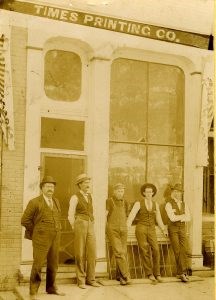
In 1898, William Fogey started the Longmont Weekly Call making Longmont a three-newspaper town. In this era, newspapers openly endorsed political parties. In its opening issue, the Ledger proclaimed itself a Republican newspaper, a stance Boynton continued throughout his career. The Call endorsed Republican candidates. The Daily Times sided with the Democrats.
About this time, a significant technological advance, the linotype, greatly reduced the amount of time and labor needed to print a page. Hot metal typesetting allowed printers to cast an entire line of type at once. The young Ray Lanyon, shown operating the linotype in the photo below, would go on to purchase The Daily Times in 1919.
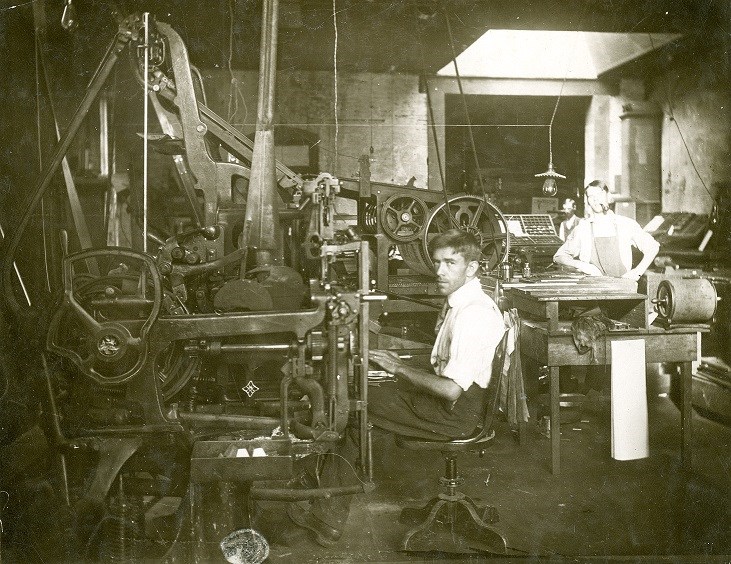
In the 1920s, the issue of the Ku Klux Klan divided Longmont and its newspapers. The Ledger supported the Klan through its coverage without openly endorsing it. For instance, when the Klan hung an electric cross on the city Christmas tree, the Ledger provided it with a positive spin. The Daily Times covered stories detrimental to the Klan’s objectives, such as when politicians spoke out against it.
When C. W. Boynton died in 1926, his daughter Louise Boynton Clark, who had been serving as associate editor and assistant manager, published the newspaper for a few months. She sold it in October 1926 to Irvin G. Stafford, formerly publisher of the Loveland Reporter.
In 1931, the Longmont Call merged with the Longmont Daily Times becoming the Longmont Times-Call. In 1957, Ed and Ruth Lehman purchased the Times-Call and began a major modernization introducing electronic engraving for faster photo reproductions and perforated teletype tape to speed up the linotype machine. They changed the newspaper’s name from the Longmont Times-Call to the Longmont Daily Times-Call. In 1964, the Longmont Daily Times-Call moved from a storefront on 4th Avenue to a 12,000 square foot building at 4th and Terry.
After more than 90 years the Longmont Ledger, then the Longmont Commercial Ledger, ceased publication in 1971 making the Daily Times-Call the sole remaining newspaper in Longmont. In the early 1970s, the Times-Call eliminated metal type through the technology of phototypesetting, a photographic process that generates columns of type on a scroll of photographic paper. This allowed color printing.
In 2011, The Daily Times-Call was purchased by Prairie Mountain Publishing, which also publishes The Boulder Daily Camera. Prairie Mountain Publishing is a subsidiary of Digital First Media.
According to Wikipedia, "Digital First Media, formerly MediaNews Group, is a management company specializing in newspapers in the United States. It is headquartered in Denver, Colorado. It is owned by Alden Global Capital, a New York-based hedge fund specializing in distressed properties."
In our new millennium, the prospects of printed media have changed radically due to the prevalence of personal computers and other devices, which deliver information well before it makes it into local newspapers. This caused a downward spiral in print media’s economic viability.
While the immediate benefits of getting so much vital information online may have seemed as if it had almost no downside, communities like Longmont suffer serious consequences. “Communities become sickly,” says Scott Converse, publisher and co-founder of the Longmont Observer. “Crime rates go up, test scores go down, bond rates go up. We needed a local non-profit media entity that replaces the tired old newspaper model and the ‘one size fits anyone’ algorithm-driven future offered by social media.”
But how could a volunteer non-profit possibly work for a dying institution like the small city newspaper? That is exactly what Converse and Sergio Angeles, co-founder and president of the Longmont Observer, set out to find out, a volunteer-driven, online, community newspaper.
 Disheartened that the Times-Call moved out of Longmont, Sergio Angeles and Scott Converse set out to revive local news in Longmont. They believe in a local paper that is interested in the voices of the residents it serves. They felt that the best model for such a news source would be a nonprofit organization.
Disheartened that the Times-Call moved out of Longmont, Sergio Angeles and Scott Converse set out to revive local news in Longmont. They believe in a local paper that is interested in the voices of the residents it serves. They felt that the best model for such a news source would be a nonprofit organization.
The Longmont Observer was born in March of 2017 when Angeles and Converse announced a meeting on meetup.com, soliciting for interested parties to join. Half a dozen people attended to show interest and support. The first article was posted online in April of 2017. Since then the Longmont Observer has steadily increased its participation and readership. Recent numbers report that 14% of Longmont is reading this home-grown paper.
Angeles and Converse recognized that the “old” newspaper model would not work in times when most people rely on their mobile devices for their news. The duo decided to produce Longmont Observer news in a digital format. In addition, they had an opportunity to vary the media used to deliver news in the modern era, straying from the traditional written word and adopting podcasts and live-streaming to social media.
While no one knows for sure the future of journalism, the need for a local news source in every city is important. Not only does it keep its officials honest, it informs and educates its residents, allowing them to be more informed citizens.
-An aside: I would personally like to thank Erik Mason, at the Longmont Museum, for his assistance in educating me on the history of newspapers in Longmont. A few years ago, he gave a speech covering this topic, from which I gathered much of my information. Thank you, Erik for your hard work and for generously taking the time to share your research with the Longmont Observer and me.


